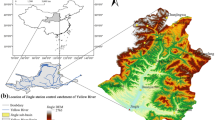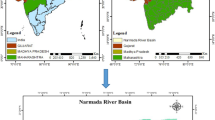Abstract
The classification and identification can increase the prediction accuracy effectively due to the complexity and regularity of flood formation. However, it is difficult to extract the influence indicators, especially in data-sparse basins. This research proposes a framework for flood classification and dynamic flood forecast identification in data-sparse basins. The framework starts from a new perspective for flood classification and introduces the concept of forgetting mechanism for flood identification. In the framework, the Data-Based Mechanistic (DBM) forecasting model, a data-driven model with a physically mechanistic interpretation, has been selected as the basic simulated model; then a flood classification model based on DBM and the process of flood occurrence and development has been built to classify floods and generate the corresponding sub-cluster models, and the similarity of the process of flood occurrence and development for each flood is described as the similarity of the simulated model trained for each flood; the forgetting mechanism, which can eliminate the out-of-date data gradually to reduce the influence of the misleading information, is coupled with the deterministic coefficient to identify one of the sub-models for the dynamic flood forecast. The framework has been tested in Shihuiyao Basin, Northeastern China. Results show that the average deterministic coefficients of the proposed framework are 0.87 and 0.86, which are 0.05 and 0.16 higher than those without classification and identification (0.82 and 0.70). The established framework provides a new idea for flood classification and identification, which has the advantages of ease of use, good generality, and low data requirements.








Similar content being viewed by others
Availability of Data and Material
The data that support the findings of this study are available from the corresponding author upon reasonable request.
Code Availability
Not applicable.
References
Abbott MB, Bathurst JC, Cunge JA, O’Connell PE, Rasmussen J (1986) An introduction to the European hydrological system-systeme hydrologique Europeen, “SHE”, 2: Structure of a physically-based, distributed modelling system. J Hydrol 87(1):61–77
Basu B, Srinivas VV (2014) Regional flood frequency analysis using kernel-based fuzzy clustering approach. Water Resour Res 50(4):3295–3316
Beven KJ, Kirkby MJ (1979) A physically based, variable contributing area model of basin hydrology / Un modèle à base physique de zone d’appel variable de l’hydrologie du bassin versant. Hydrol Sci Bull 24(1):43–69
Chang F-J, Chen Y-C, Liang J-M (2002) Fuzzy clustering neural network as flood forecasting model. Hydrol Res 33(4):275–290
Ciarapica L, Todini E (2002) TOPKAPI: a model for the representation of the rainfall-runoff process at different scales. Hydrol Process 16(2):207–229
Diao Y, Wang B (2010) Risk analysis of flood control operation mode with forecast information based on a combination of risk sources. SCIENCE CHINA Technol Sci 53(7):1949–1956
Garrote L, Bras RL (1995) A distributed model for real-time flood forecasting using digital elevation models. J Hydrol 167(1):279–306
Gu S, Tan Y, He X (2013) Recentness biased learning for time series forecasting. Inf Sci 237:29–38
Hirabayashi Y, Mahendran R, Koirala S, Konoshima L, Yamazaki D, Watanabe S, Kim H, Kanae S (2013) Global flood risk under climate change. Nat Clim Chang 3(9):816–821
Jakeman AJ, Littlewood IG, Whitehead PG (1990) Computation of the instantaneous unit hydrograph and identifiable component flows with application to two small upland catchments. J Hydrol 117(1):275–300
Jonkman SN (2005) Global perspectives on loss of human life caused by Floods. Nat Hazards 34(2):151–175
Kalman RE (1960) A new approach to linear filtering and prediction problems
Lees M (1994) An adaptive flood warning scheme for the River Nith at Dumfries, 2nd International Conference on River Flood Hydraulics 65–75
Liang X, Wood EF, Lettenmaier DP (1996) Surface soil moisture parameterization of the VIC-2L model: Evaluation and modification. Glob Planet Chang 13(1):195–206
Liang X, Lettenmaier DP, Wood EF, Burges SJ (1994) A simple hydrologically based model of land surface water and energy fluxes for general circulation models. J Geophys Res Atmos 99(D7):14415–14428
Liao L, Zhou J, Zou Q (2013) Weighted fuzzy kernel-clustering algorithm with adaptive differential evolution and its application on flood classification. Nat Hazards 69(1):279–293
Mediero L et al (2015) Identification of coherent flood regions across Europe by using the longest streamflow records. J Hydrol 528:341–360
O’Connell P, Todini E (1996) Modelling of rainfall, flow and mass transport in hydrological systems: an overview. J Hydrol 175(1–4):3–16
Razavi S, Araghinejad S (2008) Reservoir inflow modeling using temporal neural networks with forgetting factor approach. Water Resour Manage 23(1):39–55
Ren M, Wang B, Liang Q, Fu G (2010) Classified real-time flood forecasting by coupling fuzzy clustering and neural network. Int J Sedim Res 25(2):134–148
Romanowicz RJ, Young PC, Beven KJ (2006) Data assimilation and adaptive forecasting of water levels in the river Severn catchment, United Kingdom. Water Resour Res 42(6)
Rujner H, Leonhardt G, Marsalek J, Viklander M (2018) High-resolution modelling of the grass swale response to runoff inflows with Mike SHE. J Hydrol 562:411–422
Schumann GJP (2014) Fight floods on a global scale. Nature 507(7491):169–169
Song T, Ding W, Wu J, Liu H, Zhou H, Chu J (2020) Flash flood forecasting based on long short-term memory networks. Water 12(1)
Taylor CJ, Pedregal DJ, Young PC, Tych W (2007) Environmental time series analysis and forecasting with the Captain toolbox. Environ Model Softw 22(6):797–814
Tongal H, Sivakumar B (2017) Cross-entropy clustering framework for catchment classification. J Hydrol 552:433–446
Turkington T, Breinl K, Ettema J, Alkema D, Jetten V (2016) A new flood type classification method for use in climate change impact studies. Weather Clim Extremes 14:1–16
Wei G, Tych W, Beven K, He B, Ning F, Zhou H (2018) Nierji reservoir flood forecasting based on a Data-Based Mechanistic methodology. J Hydrol 567:227–237
Wu J, Liu H, Wei G, Song T, Zhang C, Zhou H (2019) Flash flood forecasting using support vector regression model in a small mountainous catchment. Water 11(7)
Xu W, Peng Y (2015) Research on classified real-time flood forecasting framework based on K-means cluster and rough set. Water Sci Technol 71(10):1507–1515
Young PC (2002) Advances in real–time flood forecasting, in Philosophical Transactions of the Royal Society of London. Series A: Mathematical, Physical and Engineering Sciences, edited, pp. 1433–1450, Royal Society
Young PC (2011) Recursive estimation and time-series analysis: an introduction for the student and practitioner, Springer Science & Business Media
Young PC, Beven KJ (1994) Data-based mechanistic modelling and the rainfall-flow non-linearity. Environmetrics 5(3):335–363
Young PC, Romanowicz RJ, Beven K (2014) A data-based mechanistic modelling approach to real-time flood forecasting, Applied Uncertainty Analysis for Flood Risk Management, edited by: Beven. KJ and Hall, JW, Imperial College Press, London, pp 407–461
Zhang Y, Wang G, Peng Y, Zhou H (2011) Risk analysis of dynamic control of reservoir limited water level by considering flood forecast error. SCIENCE CHINA Technol Sci 54(7):1888–1893
Zhao J, Wang Z, Park DS (2012) Online sequential extreme learning machine with forgetting mechanism. Neurocomputing 87:79–89
Zhao R-J (1992) The Xinanjiang model applied in China. J Hydrol 135(1–4):371–381
Zhao T, Zhao J, Lund JR, Yang D (2014) Optimal hedging rules for reservoir flood operation from forecast uncertainties. J Water Resour Plan Manag 140(12)
Zhou X, Liu Z, Zhu C (2014) Online regularized and kernelized extreme learning machines with forgetting mechanism. Math Probl Eng 2014:1–11
Funding
The research is supported by National Natural Science Foundation of China (grant number 51779030) and the CAS ‘Light of West China’ Program (grant number Y8R2230230).
Author information
Authors and Affiliations
Contributions
Not applicable.
Corresponding author
Ethics declarations
Ethical Approval
Not applicable.
Consent to Participate
Not applicable.
Consent to Publish
Not applicable.
Conflicts of Interest/Competing Interests
The authors declare that there is no conflict of interest.
Additional information
Publisher's Note
Springer Nature remains neutral with regard to jurisdictional claims in published maps and institutional affiliations.
Rights and permissions
About this article
Cite this article
Wei, G., Ding, W., Liang, G. et al. A New Framework Based on Data-Based Mechanistic Model and Forgetting Mechanism for Flood Forecast. Water Resour Manage 36, 3591–3607 (2022). https://doi.org/10.1007/s11269-022-03215-z
Received:
Accepted:
Published:
Issue Date:
DOI: https://doi.org/10.1007/s11269-022-03215-z




